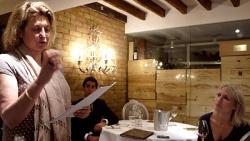 I VENTURED to the beamed vault under ‘Angelus’, Lancaster Gate for an early tasting of old spirits. There, behind a glass partition on a scrubbed flagstone floor slumber crates of the 1er grand cru classé St. Emilion which lends the restaurant its name.
I VENTURED to the beamed vault under ‘Angelus’, Lancaster Gate for an early tasting of old spirits. There, behind a glass partition on a scrubbed flagstone floor slumber crates of the 1er grand cru classé St. Emilion which lends the restaurant its name.
Presenting four expressions of Armagnac from the 16 hectares of ‘Castarède’ was sixth generation head of the house, Florence. As the auburn liquids were allowed to mingled with air, Florence explained how Armagnac, which at 700 years this year is France’s oldest appellation, differs to cognac, which came a quarter of a millennia later. This is down to geography and quantity, maturation and mentality, and even gender…
Armagnac, which comes from vines sewn on chalk 100 miles to the south of calcareous Cognac, has an annual production of six million bottles – a fraction of the output of even one cognac house (Hennessey is estimated to sell 2.5 million cases). Inexplicably, many of Armagnac’s 800 houses are run by women, compared to few in cognac and fewer still in Calvados. Tough hybrid grape, Baco is used in Armagnac in addition to the Folle Blanche, Ugni Blanc and Colombard, which appear in both brandies. Harvested in September, these are distilled just once in a continuously operating still, lending a lesser strength than cognac. This process retains the spirit a greater breadth of flavours and requires less dilution when settling it to a saleable alcoholic level. Aside from the curiosity that is white Armagnac, the spirit is then matured in casks sprung from dense, black, locally grown oak versus Cognac’s bought-in, lighter Limousin.
By law Armagnac’s expressions, XO and VSOP must be matured for a minimum of five and six years respectively. In no hurry, however, Castarède prefers to bottle these at 10-15 and 20-25 years, with vintages (exceptional in Cognac) actually bottled to order.
Better to Breathe
On this showing, Castarède’s VSOP wove the unlikely combination of Christmas spices with cantaloupe melon and noticeable, but plush oak, whilst the XO was creamier, more mellow with a longer finish, although the most apparent alcohol. The ’79 showed a gentle evolution, with floral scents and orange trails. Perhaps predictably, my favourite was the ’69, a bright, lifted, highly drinkable Armagnac with orange cream in its pleasurably persistent finish.
After the tasting, Florence revealed embarrassment at another – I would like to think – less studious panel of sommeliers who were fooled into thinking that one bottle served blind at ten minute intervals was actually several completely different expressions. ‘It just shows how Armagnac changes with time in the glass’, she said, charitably.
Traditionally, Castarède gifts heads of state bottles from their birth years, including Jacques Chiraq (’32) and Tony Blair (’53). Only George W. Bush admitted concern, however, believing a bomb to be secreted within his ’46. That, I suppose, serves Castarède right – serving up strong liquor to an alcoholic was at best a mischievous move.
Angelus’ proprietor, Gascon, Thierry Tomasin mentioned that he would love more customers at his restaurant to experience the quality of Armagnac by being prepared to pay for the ‘patience’ it takes to raise each bottle. But indiscriminate governmental taxes result in the same duty being applied to his stock of ’45 and ’79 Castarède as to ‘crap vodka’ in nightclubs. Exacerbating, the smoking ban prevents the habitual accompaniment of a cigar.
Expecting him to recommend his signature fois gras brûlée as a pairing with the spirit, Tomasin instead said that he prefers not to make matching suggestions because palates differ from customer to customer. Rather philosophically, he explained: ‘some people love a Rolls Royce and others a Mini – but they’ll both get you to Brighton…’
The death of the long business lunch in favour of an era where office workers ‘could end up being breathalysed afterwards in the office’ is also a factor contributing to lesser consumption of alcohol in general. Angelus, therefore now opens all-day. ‘As a result, we are seeing more customers come in from 3:30pm than at lunch’ said Thomasin, simulating the raising of a glass.
Castarède‘s UK importer is Enotria
Angelus – 4 Bathurst St., London. W2 2SD
